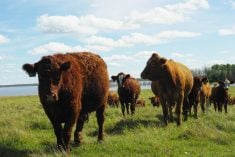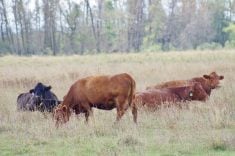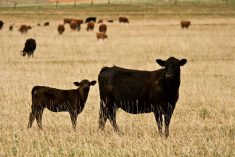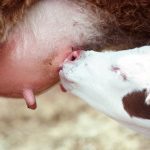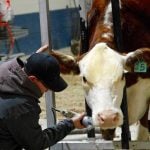Compared to last week, Western Canadian feeder cattle markets traded $4-$8/cwt lower while some packages of heavier replacements dropped as much as $12/cwt, and three main factors led to weaker prices.
First, the deferred live cattle futures are now $15 off the recent highs. Margins for the fall period were under water at the highs and the feeding economics have deteriorated. Bottom line results on six to eight month budgets are starting to look threatening. Second, pen conditions are rated poor to very poor due to recent snow in Southern Alberta. Finally barley prices appear to be ratcheting higher. The lower prices over the past month have enhanced offshore sales. The year-over-year decrease in corn acres could result in a significant corn rally. This would cause a $10-$15/cwt drop in the feeder cattle futures and pressure the Western Canadian yearling market during the fall.
Read Also

New opportunities for Canadian goods in Mexico
Agriculture minister’s trip to Mexico sees promotion of Canadian goods like beef and canola, with potential for more partnerships in the future
In Central Alberta, a larger group of medium to lower flesh mixed steers averaging 900 pounds on light barley and corn silage diet with full processing data traded for $324. North of Calgary, larger frame Charolais blended heifers on light grain and silage ration weighing 880 pounds were valued at $293 fob farm.
Northwest of Winnipeg, Charolais steers carrying lighter flesh and weighing a shade over 800 pounds dropped the gavel at $342. However, in Central Saskatchewan, Angus blended, 815-pound steers carrying medium-to-thicker butter on backgrounding light grain diet reportedly sold for $321. A smaller group of fleshier, mixed heifers averaging 810 pounds supposedly traded for $305 in the same region.
In Central Alberta, a larger group of Simmental mixed steers with lower flesh levels on forage and hay diet, with known health records, weighing 700 pounds apparently moved at $366. In the same region, similar quality and weight heifers were quoted at $329.
In Southern Manitoba, red and black weaned steer calves around 625 pounds apparently dropped the gavel at $425. North of Brandon, mixed weaned heifers on the card at 610 pounds supposedly notched the board at $352.
Sale reports for calves around 500 pounds were all over the map. Northwest of Winnipeg, a smaller group of black steers averaging 500 pounds were quoted at $437. In Central Saskatchewan, 500-pound Charolais and Angus weaned steers were quoted in the range of $465-$470. Northeast of Calgary, Limousin blended weaned steers around 505 pounds were silenced bidders at $480.
Markets can become extremely sensitive near historical highs. The live and feeder cattle futures are incorporating a risk discount due to the uncertainty in demand due to the U.S. bird flu outbreak.
— Jerry Klassen is president and founder of Resilient Capital, specializing in proprietary commodity futures trading and market analysis. Jerry consults with feedlots on risk management and writes a weekly cattle market commentary. He can be reached at 204-504-8339 or via his website at ResilCapital.com.





